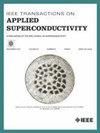Structural Design and Analysis of 14 T Animal MRI Superconducting Magnet
IF 1.8
3区 物理与天体物理
Q3 ENGINEERING, ELECTRICAL & ELECTRONIC
引用次数: 0
Abstract
High field magnetic resonance imaging (HF-MRI) systems can achieve higher image resolution and sensitivity, resulting in better image quality and more biological information, which has significant value in life science and clinical medicine applications. The development of HF-MRI system depends on the development of high field superconducting magnet. HF-MRI superconducting magnet needs to solve problems such as high magnetic field uniformity requirements, large stray field range, high coil electromagnetic stress, and shrinkage stress in low-temperature systems. This article introduces the design and optimization process of 14 T at 175 mm warm bore size animal MRI superconducting magnet. We used a nonlinear multiobjective programming algorithm to simultaneously optimize warm bore space (diameter 175 mm), magnetic field homogeneity and the stray magnetic field (5 Gauss line) for a 14 T MRI magnet. The spatial position, electromagnetic density, and electromagnetic stress of different coils are obtained, and the design stability of magnet coil is evaluated using coil loading ratio and current safety margin. In addition, the magnet coil former is designed, and the finite element method is used to perform mechanical simulation analysis on the coil former. The optimization results show that the warm bore of the magnet is 175 mm, and the homogeneity of the magnet design is 1.1 ppm at 60 mm DSV, magnet stray field (5 Gauss line) is 2.9 m in the axial direction, and 2.4 m in the radial direction from the center of the magnetic field. The minimum safety margin of the magnet coil is 10.6%, and the maximum hoop stress of the magnet coil is 225 MPa. The magnet meets the design requirements and provides necessary reference for the engineering prototype of the 14 T animal MRI superconducting magnet.14t动物MRI超导磁体结构设计与分析
高场磁共振成像(HF-MRI)系统可以实现更高的图像分辨率和灵敏度,从而获得更好的图像质量和更多的生物信息,在生命科学和临床医学应用中具有重要价值。高频磁共振成像系统的发展依赖于高场超导磁体的发展。HF-MRI超导磁体需要解决低温系统中磁场均匀性要求高、杂散场范围大、线圈电磁应力高、收缩应力大等问题。本文介绍了14t 175 mm温孔动物MRI超导磁体的设计与优化过程。采用非线性多目标规划算法,同时优化14t MRI磁体的热孔空间(直径175 mm)、磁场均匀性和杂散磁场(5高斯线)。得到了不同线圈的空间位置、电磁密度和电磁应力,并利用线圈负载比和电流安全裕度评价了电磁线圈的设计稳定性。此外,设计了磁体线圈成型机,并采用有限元法对成型机进行了力学仿真分析。优化结果表明,该磁体的温孔为175 mm,在60 mm DSV处磁体均匀性为1.1 ppm,磁体杂散场(5高斯线)距磁场中心轴向2.9 m,距磁场中心径向2.4 m。电磁线圈的最小安全裕度为10.6%,电磁线圈的最大环向应力为225 MPa。该磁体满足设计要求,为14t动物MRI超导磁体的工程样机设计提供了必要的参考。
本文章由计算机程序翻译,如有差异,请以英文原文为准。
求助全文
约1分钟内获得全文
求助全文
来源期刊

IEEE Transactions on Applied Superconductivity
工程技术-工程:电子与电气
CiteScore
3.50
自引率
33.30%
发文量
650
审稿时长
2.3 months
期刊介绍:
IEEE Transactions on Applied Superconductivity (TAS) contains articles on the applications of superconductivity and other relevant technology. Electronic applications include analog and digital circuits employing thin films and active devices such as Josephson junctions. Large scale applications include magnets for power applications such as motors and generators, for magnetic resonance, for accelerators, and cable applications such as power transmission.
 求助内容:
求助内容: 应助结果提醒方式:
应助结果提醒方式:


